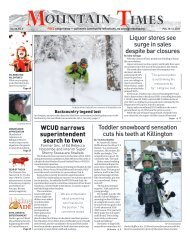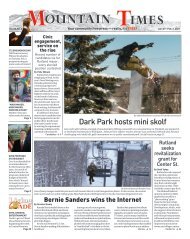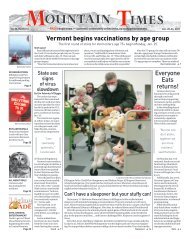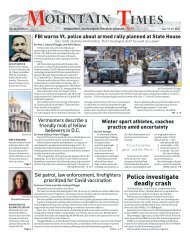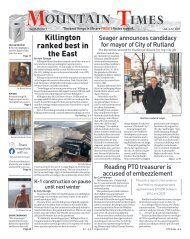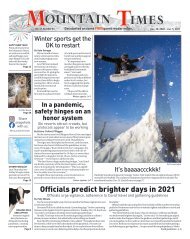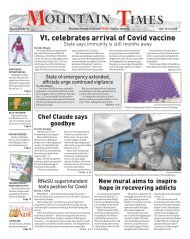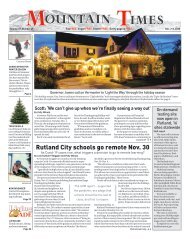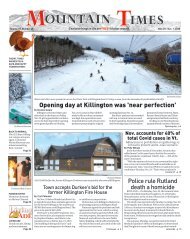Mountain Times – Volume 49, Number 17 – April 22-28, 2020
Create successful ePaper yourself
Turn your PDF publications into a flip-book with our unique Google optimized e-Paper software.
The <strong>Mountain</strong> <strong>Times</strong> • <strong>April</strong> <strong>22</strong>-<strong>28</strong>, <strong>2020</strong> • 11<br />
Ed funding: State must decide priorities<br />
><br />
from page 1<br />
make a tough decision, it was very likely that the Vermont<br />
State Colleges, which is a single corporation, would not be<br />
able to continue,” Chancellor Jeb Spaulding said Friday.<br />
Saturday, after hearing the proposal, faculty at NVU<br />
issued a no confidence vote in the chancellor, and in a<br />
separate letter to trustees called Spaulding’s recommendations<br />
a “shortsighted massacre with lasting and irrevocable<br />
consequences.”<br />
On Sunday afternoon, Gov. Phil Scott weighed in as well.<br />
The governor said while he did not support “adopting the<br />
current plan as proposed or asking taxpayers to bailout a<br />
system that is no longer financially viable,” he believed a<br />
third way was possible. “I’m calling on the Legislature to<br />
begin work immediately on a statewide plan to rethink,<br />
reform and strengthen the education system in ways that<br />
are fair and equitable to every student, every community<br />
and every taxpayer,” Scott said in a statement.<br />
Trustees for the Vermont State Colleges met Monday,<br />
but postponed a decision on Spaulding’s restructuring<br />
proposal for at least a week to allow for further debate and<br />
discussion.<br />
Whether Spaulding’s plan is ultimately adopted or not, it<br />
is likely to reignite a debate about funding for public higher<br />
education — and public education writ large. Vermont<br />
perennially ranks at the bottom nationally in state support<br />
for its colleges, forcing the schools to rely on student tuition<br />
and fees for over 80% of their revenues.<br />
On Monday, <strong>April</strong> 20, at a press conference, Governor<br />
Scott said the plight of “Vermont State Colleges is just the tip<br />
of the iceberg,” and that tough budgetary choices “would<br />
affect K-12, too, down the road.”<br />
“There’s going to be a lot of need,” he continued, listing<br />
hospitals, K-12 schools and municipalities as just a few of<br />
those that are also going to face budgetary shortfalls and<br />
warned of even more difficult decisions that lawmakers<br />
are going to have to make in the coming months. “There<br />
is not an infinite amount of money… We’re going to have<br />
to prioritize… I think it’s time that we rethink our public<br />
education system in its entirety.”<br />
The state of Vermont spends over $1.8 billion on K-12<br />
education, plus about $100 million for higher education<br />
each year, Scott said, Monday.<br />
But this year, the state will face a shortfall in projected<br />
collections to cover those costs. According to the Joint Fiscal<br />
Office’s latest projection, “the Education Fund deficit for FY<br />
2021 could be as high as $150 million. The deficit in the Education<br />
Fund is caused mainly by a decrease in consumption<br />
tax revenues,” wrote Sue Ceglowski, executive director for<br />
the Vermont School Board Association, in a letter ot the<br />
board <strong>April</strong> 20.<br />
The VSC faced a $4.2 million deficit prior to the pandemic<br />
and additional losses of about $10 million because of<br />
it, Spauding said.<br />
“If we better coordinate, we could have a better system<br />
with less money… This maybe is the opportunity to get creative<br />
and develop the best education system we can. We’re<br />
small, unique, and we can be nimble, if we think outside the<br />
box we can get a better product for kids in the end. For the<br />
full spectrum of students from early education through to<br />
higher ed.”<br />
Xander Landen and Lola Duffort/VTDigger contributed<br />
to this report.<br />
By Glenn Russell/VTDigger<br />
The VSC campus of Northern Vermont University-Lyndon<br />
in Lyndonville, one school proposed to close.<br />
By Shelby Perry, Northeast Wilderness Trust<br />
There are nearly two miles of cascading tributaries of the Ottauquechee River on the Bramhall Wilderness Preserve.<br />
><br />
Bramhall Wilderness: Northeast Wilderness Trust purchased 359 acres in Bridgewater<br />
from page 1<br />
executive director of the<br />
Wilderness Trust. “They are<br />
remarkably effective at storing<br />
vast amounts of carbon,<br />
and they offer habitats to a<br />
wide array of species that<br />
will need space to move<br />
and adapt as the climate<br />
becomes hotter and more<br />
unpredictable.”<br />
The Preserve lies just<br />
south of the Appalachian<br />
Trail as it winds its way<br />
down from the Green<br />
<strong>Mountain</strong>s to the Connecticut<br />
River. Nearly two miles<br />
of waterways, including<br />
the North Branch of the<br />
Ottauquechee River and<br />
two smaller tributaries,<br />
tumble through the steep<br />
hills of the Preserve. Dense<br />
hemlocks shade the water,<br />
creating prime habitat for<br />
native brook trout.<br />
Northeast Wilderness<br />
Trust is working with the<br />
Vermont River Conservancy<br />
(VRC) and the Vermont<br />
Housing & Conservation<br />
Board (VHCB) on the permanent<br />
conservation of the<br />
land. VRC and VHCB will<br />
co-hold forever-wild legal<br />
protections on the preserve.<br />
“We are excited to<br />
partner with Northeast Wilderness<br />
Trust for the sake of<br />
public access to the rivers in<br />
the beautiful Bramhall Preserve,”<br />
said Lydia Menendez<br />
Parker, asst. director of<br />
VRC. “Low-impact recreational<br />
access paths from<br />
the parking pull-out will<br />
support those adventurers<br />
looking for a place to dip in<br />
the cool, refreshing waters<br />
and cast a line.”<br />
VHCB played a key role<br />
in in protecting the land<br />
with a $160,000 grant.<br />
Gus Seelig, executive<br />
director of VHCB, said:<br />
“Situated as it is in the<br />
center of 60,000 acres of<br />
managed forestland in<br />
federal, state, municipal<br />
and private ownership,<br />
this core block of land will<br />
remain forever wild and<br />
provide permanent public<br />
access for swimming,<br />
hunting, fishing, and hiking.<br />
The Bramhall Wilderness<br />
Preserve will create a<br />
unique learning laboratory<br />
for scientists, naturalists,<br />
and educators to compare<br />
natural processes over time<br />
to the managed forestland<br />
surrounding it, helping<br />
community members<br />
and visitors to better<br />
understand the ecological<br />
benefits of old forest.”<br />
Last semester, Woodstock<br />
High School ran a wilderness<br />
studies class about<br />
nature, conservation, and<br />
wildlands. The students<br />
spent two field days on the<br />
preserve for experiential<br />
outdoor learning.<br />
“It is vital that students<br />
take time in school to<br />
develop their personal<br />
relationship with nature,<br />
wilderness, and society,”<br />
said Sophie Leggett, a student<br />
who served as teaching<br />
assistant for the class.<br />
“Moreover, we are lucky to<br />
be working with the Northeast<br />
Wilderness Trust to<br />
have a deep and meaningful<br />
educational experience<br />
with local wilderness. Using<br />
the Bramhall Preserve<br />
“The fact that this dream I have had<br />
most of my life is now a reality [for]<br />
the acres my mom left me—that they<br />
are now and will be forever wild—is<br />
still sinking in,” said Bramhall.<br />
as a lens for more global<br />
thinking, this class is a step<br />
in developing personal and<br />
cultural values surrounding<br />
wilderness.”<br />
The Wilderness Trust<br />
prohibits timber harvest,<br />
vehicles, trapping, mining,<br />
agriculture, subdivision,<br />
and development on all<br />
forever-wild properties.<br />
“Paedra has allowed nature<br />
to take charge on this<br />
land for decades and we<br />
will continue that legacy,”<br />
said Shelby Perry, stewardship<br />
director of Northeast<br />
Wilderness Trust. “From<br />
this day forward, the forest<br />
will always continue to<br />
grow old and wild per her<br />
wishes, providing diverse<br />
wildlife habitat and storing<br />
carbon indefinitely.”<br />
The new Bramhall Wilderness<br />
Preserve is part of<br />
the Wilderness Trust’s Wild<br />
Carbon initiative. Through<br />
this program, the new<br />
Preserve will be aggregated<br />
with other Wilderness<br />
Trust properties across<br />
four states. The goal of the<br />
program is to sell carbon<br />
credits from the combined<br />
properties to generate<br />
funds for future wilderness<br />
conservation.<br />
“We are far from living<br />
in a carbon-neutral<br />
world,” explained Sophie<br />
Ehrhardt, the wildlands<br />
partnership coordinator<br />
for Northeast Wilderness<br />
Trust. “This carbon project<br />
will provide an original<br />
model for other organizations<br />
who want to preserve<br />
land. This program creates<br />
income from carbon<br />
storage rather than timber<br />
harvest.”<br />
The Wilderness Trust’s<br />
first Wild Carbon sale was<br />
completed in 2016 on two<br />
of its preserves in Maine.<br />
“Funding to protect wild<br />
places is scarce,”Ehrhardt<br />
added, “so carbon credits<br />
are a creative way to build a<br />
wilder future.”<br />
Although enough funds<br />
were raised to buy and create<br />
the Bramhall Preserve,<br />
the Wilderness Trust is still<br />
working to raise $204,000<br />
to secure the long-term<br />
stewardship and care of<br />
the property.<br />
For more information,<br />
visit newildernesstrust.<br />
org/bramhall or call 802-<br />
<strong>22</strong>4-1000.





